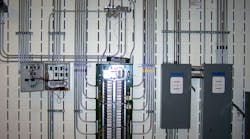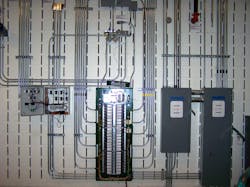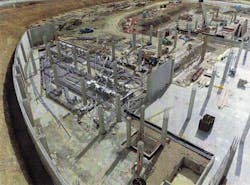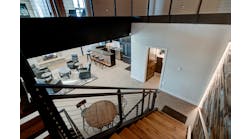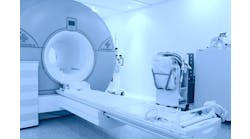BIM and Prefabrication Keep Hospital Project on the Fast Track
When building a hospital on an accelerated schedule, a construction team invents ways to improve the efficiency of its field workforce, meet deadlines, and circumvent design conflicts. By relying on computer modeling and prefabrication, contractors were able to build a new 550,000-sq-ft hospital structure on a 60-acre open site, which replaced two existing hospitals located elsewhere in Cincinnati.
“The aggressive schedule was one of the biggest challenges on this project,” says John Gatton, senior on-site project manager for Faith Technologies, one of the electrical contracting firms working on the Mercy Health-West Hospital project in Green Township, Ohio. “We only had 27 months from the design process to opening the hospital.”
Faith Technologies had a $15-million contract for all of the power and distribution, lighting, and fire alarm systems work for Mercy Health-West Hospital. The contracting firm had a joint venture relationship with Denier Electric for the overall electrical portion of the project. The two companies worked with Turner Construction, the general contractor; Champlin Architecture, the architecture firm; and Heapy Engineering, the electrical engineer, to construct the new hospital.
Offering the latest technology in health care
To meet the community’s needs, the construction team built a Community and Education Center and a Medical Office Building at the hospital complex. The facility includes a heart center — with capability for open heart surgery — a cancer center, a family birth center, a women’s center, and an orthopedics program.
All patient rooms are private and consist of three zones: a patient zone, staff zone, and family zone, with a sleeper sofa and separate lighting system. The new hospital includes more than 250 patient beds in two towers, and each tower has five floors. On the campus, the team constructed a parking garage and installed three 2MW generators, a primary substation, and four unit substations.
To illuminate the hospital, electricians installed LED lighting on the exterior of the buildings (Photo 1) and a blend of LED and fluorescent lighting in the individual patient rooms. In addition, Faith Technologies installed occupancy controls and sensors in the auditorium space, on the exterior of the building, and in all of the offices and public spaces.
Saving time through prefabrication
To improve efficiency for the more than 90 electricians in the field, Faith Technologies turned to prefabrication. All corridor ceilings within the patient tower area were built off-site in a prefabrication facility to include all conduit connection points required in the field. The corridor ceilings or racks showed up on the job site in 20-ft to 25-ft sections, which workers attached to the concrete ceilings using previously installed anchor points. The in-wall rough-ins were already done when the electricians arrived on site, further boosting productivity for the field workforce.
“This saved us about 15% in labor for that process,” says Jason Spang, vice president, western Wisconsin, for Faith Technologies.
The bathrooms were also pre-manufactured off-site and brought to the facility as a finished pod, requiring only final connections to be made on-site. To ease this process in the field, all branch wiring conductors were pre-spooled for each conduit home run. Overall, the team installed 255 pre-manufactured bathroom pods in the new hospital.
Another critical part of the project was the in-time delivery of all the materials, Gatton says. With this method, all the items could be transported to the job site as the electricians and other workers needed them.
To simplify the delivery process and make it more organized, Faith Technologies assembled boxes for each room of the hospital. Each box included a map, a drawing, and the materials that were needed for completing work in that particular room.
Meeting challenges through modeling
Another way Faith Technologies was able to save time on the project was through building information modeling (BIM) and CAD drawings.
Because the building was made out of concrete, the electricians had to ensure that all the anchors were in the proper position before the concrete was poured for the walls and floors. Through BIM modeling, they were able to coordinate the space for the raceways and install them prior to the other trades working in that particular space.
The construction team used a GPS-locating device to identify critical anchors, junction boxes, and interior/exterior lighting points throughout the facility.
The project started with the under slab conduit rough-in prior to the structure of the building being poured (Photo 2). Once they wrapped up work on the under slab, the team focused on the heart of the hospital, which was the electrical distribution system. Once the remainder of the hospital structure was in place, the crews could begin working on all areas and floors.
With such a large workforce on the project, it was essential to have solid coordination and organization. To ensure tasks were done properly and on time, Faith Technologies sectioned off portions of the project to high-level field leaders.
Faith Technologies also worked closely with Turner Construction, Mercy Hospital, and manufacturers to install the owner-furnished equipment and relocate critical medical equipment from the two existing hospitals. As part of its contractor assist capabilities, the electrical contracting firm helped bring a new MRI unit into the hospital and relocate an MRI from an existing facility. The company also worked with medical equipment vendors to equip the CT scanning and radiation and X-ray rooms with the proper technology.
“There were extensive meetings as well as site visits to existing hospitals to make the removal and re-installation of equipment go smoothly,” Gatton says. “The operating lights and equipment booms in the operating rooms required close coordination and layout of the rooms to accomplish this as well.”
The project team worked together on the equipment installation and relocation to accomplish a seamless move from the two existing hospitals to the new facility. All of the patients will be moved to the new facility one day, so everything had to be ready for them when they arrive at the new facility.
Safety was an integral part of the project as well. While there was no site-specific training for the project, the construction team followed the safety guidelines of the three key players: Turner Construction, Faith Technologies, and Denier Electric. The companies had task-specific daily toolbox talks, completed weekly job-site safety audits, and performed weekly job walks with all trades.
By focusing on providing a safe and productive work environment, the firms were able to construct a new hospital on the fast track and meet the health care needs for Ohio residents.
Fischbach is a freelance writer based in Overland Park, Kan. She can be reached at [email protected].
